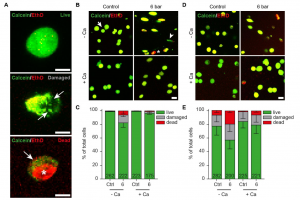During bioprinting, cells are suspended in a viscous bioink and extruded under pressure through small diameter printing needles. The combination of high pressure and small needle diameter exposes cells to considerable shear stress, which can lead to cell damage and death. Approaches to monitor and control shear stress-induced cell damage are currently not well established. To visualize the effects of printing-induced shear stress on plasma membrane integrity, we add FM 1-43 to the bioink, a styryl dye that becomes fluorescent when bound to lipid membranes, such as the cellular plasma membrane. Upon plasma membrane disruption, the dye enters the cell and also stains intracellular membranes. Extrusion of alginate-suspended NIH/3T3 cells through a 200 µm printing needle led to an increased FM 1-43 incorporation at high pressure, demonstrating that typical shear stresses during bioprinting can transiently damage the plasma membrane. Cell imaging in a microfluidic channel confirmed that FM 1- 43 incorporation is caused by cell strain. Notably, high printing pressure also impaired cell survival in bioprinting experiments. Using cell types of different stiffness, we find that shear stress-induced cell strain, FM 1-43 incorporation and cell death were reduced in stiffer compared to softer cell types and demonstrate that cell damage and death correlate with shear stress-induced cell deformation. Importantly, supplementation of the suspension medium with physiological concentrations of CaCl2 greatly reduced shear stress-induced cell damage and death but not cell deformation. As the sudden influx of calcium ions is known to induce rapid cellular vesicle exocytosis and subsequent actin polymerization in the cell cortex, we hypothesize that calcium supplementation facilitates the rapid resealing of plasma membrane damage sites. We recommend that bioinks should be routinely supplemented with physiological concentrations of calcium ions to reduce shear stress-induced cell damage and death during extrusion bioprinting.
Read the full publication in Biofabrication.


